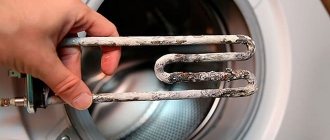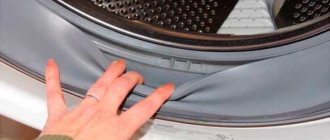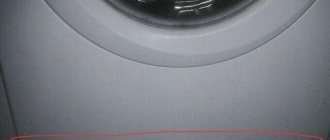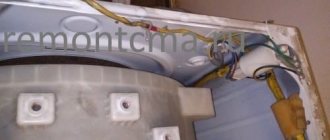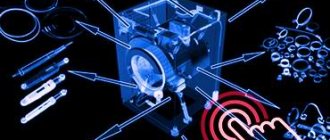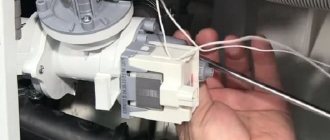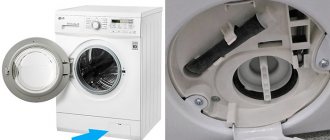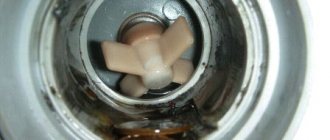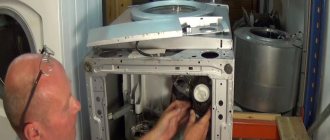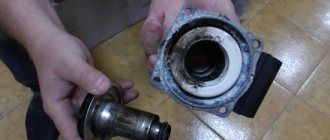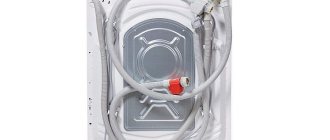All household appliances fail sooner or later, but if to repair an electric lamp it is enough to replace the light bulb, then to restore the functionality of a complex device you will need
have a sufficient amount of free time and the minimum required level of knowledge. A washing machine is just such a product, so self-repair is fraught with many difficulties, especially when it is necessary to disassemble this device for repair.
Often the washing machine pump fails, and if this part cannot be restored, then it must be replaced. To perform this operation, you need to disassemble the washing machine and remove the faulty drainage device.
Washing machine drain mechanism
This operation must be performed strictly in a certain sequence, so before you begin removing this part, you need to know exactly where the drain mechanism is located and how it works correctly.
Drain pump: operating principle
After the end of the washing or rinsing cycle, the electronic control unit sends a signal to the solenoid valve to turn on the drain mechanism. Forced removal of liquid is necessary to reduce washing time, so the washing machine is equipped with a powerful pump that allows you to pump out the entire volume of liquid inside the machine’s tank within a short time.
To prevent small particles from entering the interior, the drain mechanism has a washing machine drain pump filter.
Washing machine drain filter
Thanks to reliable protection against solid objects getting on the impeller, it is possible to achieve a long service life of the pump, but if for some reason such a “fuse” does not work, then even a small plastic button caught in the internal cavity can cause failure of this part.
If the drain of the machine stops working, then it is necessary to check the pump for possible damage. How to check and replace, if necessary, the drain pump on a washing machine will be discussed below.
Signs of a faulty washing machine pump
In order not to confuse other types of washing machine breakdowns with a pump malfunction, you need to know the main signs by which you can judge that the pump has failed or its life is coming to an end. Most often, this malfunction manifests itself as follows:
- The washing machine makes a lot of noise when draining dirty water.
- The device operates normally, but the liquid is pumped out too slowly.
- The pump hums, but no water comes out at all.
- The “drain” mode is turned on, but while the system is operating, the water drainage process is automatically turned off.
If at least one sign of malfunction is observed, it must be checked. If the pump is clogged, timely cleaning will allow it to fully restore its functionality.
this detail. In order to make a diagnosis, you need to know where the pump is located on the washing machine.
Causes of pump failure
The drain pump is responsible for the final stage of washing. Its presence involves draining the water after the spin cycle. Most often, the pump fails for a number of reasons:
- There are often cases when foreign objects (small coins, buttons) get into the drum of a washing machine, which subsequently clog the filter and can cause jamming of the impellers located at the inlet of the pump.
- The impeller may be damaged, which is manifested by jerking and jamming in operation.
- The drain hose may be clogged or kinked, causing water stagnation and obstruction.
- There may be problems with the wiring, which is the connecting link in the operation of the pump itself and the washing machine control panel (display).
Practical experience with service calls related to problems with the pump is most often limited to filter clogging. Signs that may indicate this problem are the following:
- The spin and drain program runs longer than usual.
- There is an unpleasant sound when starting the drain mode, in the form of crackling and grinding sounds.
- The washing machine stops with water or half-drained laundry.
Where is the pump located?
Locating the drain mechanism at the front wall of the machine
The drain mechanism can be located in various places of the household appliance. Its location depends on what brand of washing machine was purchased. The pump can be installed:
- In the back of the car (Electrolux and Zanussi)
- Just behind the front cover (AEG, Bosch and Siemens)
- At the bottom of the machine (Whirpool, Samsung, Ariston, Beko, LG)
Having established the exact location of the drain unit, it is necessary to remove the part for inspection.
How to remove the pump?
To remove the pump you will need to prepare the following tools:
- Slotted and Phillips screwdriver.
- Set of wrenches.
- Water container.
Important! Before disassembling the body of the washing machine, be sure to disconnect the device from the electrical network and turn on the water supply tap.
If you need to remove the device, which is located at the back of the household appliance, then the sequence of actions will be as follows:
- At the bottom of the wall there is a special door, opening which you can gain access to the filter element of the drainage device.
The door behind which the filter is located - An emergency liquid drain hose is located next to the filter element. Even if the operation of the washing machine was completed as usual, it will still be necessary to remove residual liquid, which is always present in the cavity of the pump and filter element.
Draining - When the water is drained into the prepared container, the drain filter cover is removed. To do this, you need to turn it counterclockwise.
- Then, turning the pump also counterclockwise, it is removed from the bottom cover. If the model is not equipped with a bottom cover, then simply tilt the washing machine and remove the drainage device. When the cover is installed, it must first be removed by unscrewing the screws holding it in place.
- The pipes and electrical terminals are separated from the body.
Removing the pipes
When performing this operation, care should be taken not to damage the parts connected to the drain device. To easily and safely disconnect the pipes, first loosen the clamps.
After removing the drain mechanism, you can begin to inspect and clean it. In washing machines with a pump located in the front, the sequence of operation is the same, but the drain mechanism, in this case, will be “hidden” under the powder tray.
How to remove the drain pump: step-by-step instructions
The sequence for removing the pump directly depends on the model of the machine. This should be taken into account before carrying out repair work. But now let’s look at how to remove the pump through the bottom of the car:
- Disconnect the machine from the power supply.
- Shut off the water supply.
- Carefully lay the equipment on its side. In this case, the pump should be on top. To prevent damage to the housing, it is recommended to lay a soft cloth on the floor.
- Remove the bottom panel. To do this, you need to unscrew the fasteners prematurely.
- Unscrew the pump. The fasteners are located outside near the drain valve.
- Press down on the pump and remove it from the housing. Place in a prepared container.
- Release the clamps, pipes and drain hose. Drain the remaining liquid into a container.
Here is a visual video on how to remove the pump in a Bosch washing machine. By following the sequence of steps, you can easily troubleshoot problems.
This algorithm is designed to dismantle the pump along with the volute. If there is no such need, then it will be enough to simply unscrew the bolts and special latches. After this, the part is replaced. Particular attention should be paid to the condition of the snail. It needs to be cleaned of plaque and debris.
Basically, replacement in any machines is carried out using a similar technology. The difference lies in the dismantling of the panels. In some cases, the loading hatch is additionally removed.
Do-it-yourself pump repair
If the drain pump in the washing machine fails due to burnout of the electrical winding, then in this case it is necessary to replace the part. In other cases, it is often possible to restore the device to full functionality, for which you should first clean the impeller and filter. To clean the impeller, you will need to disassemble the device housing. The two halves of the working cavity of this part are usually held together with 3 screws, so it is enough to unscrew the hardware holding the pump parts together to gain access to the impeller.
Disassembling the drainage device
The cause of deterioration in the performance of the drain mechanism, as well as complete jamming of the working shaft, may be threads, hair or long wool. It is necessary to carefully inspect the impeller and shaft and, if such contamination is detected, clean them using a thin screwdriver. The inside of the cochlea also needs to be wiped to remove soap deposits on its walls.
When the parts are cleaned, wash the two halves in water without immersing the engine. Then you need to assemble the housing, connect the pipes and electrical terminals to it and install it in its original place.
When the process of installing the cleaned pump is completed, turn the machine into rinsing mode and check the operation of the drain mechanism. If the device operates in normal mode, then no more
no measures are required; if it was not possible to repair the pump in this way, then it is necessary to replace the electric drain pump in the washing machine.
Instructions for replacing the pump
Before you begin any DIY repairs, pay attention to observing all safety precautions. First, unplug the washing machine. Then turn off the water flowing inside. Most likely, the tank is full of water and you will have to drain it. Prepare a container for used water and a rag in advance to avoid flooding your neighbors. Unscrew the filter cap and try to carefully drain all the liquid.
Pull out the machine so that it is easily accessible from all sides. We prepare all the tools necessary for repairs and a large piece of fabric to put the washing machine on. Only after these preparatory work, we disconnect the decorative panel to get to the place where the pump is located.
Be prepared for the fact that the washer is quite heavy and it is not easy to lay it on its side. You can simplify your work by unscrewing the bottom from the machine, if your model has one. This can be done by removing the screws.
- First, check the drain pipe. You can feel the blockage in it.
- Then carefully remove it from the pump by loosening the clamp.
- Near the filter plug you will find retaining screws. They need to be unscrewed. Unfasten the wiring and remove the drain pump.
The easiest way is to clean the pipe under water pressure. But if, after examining it, you do not find any signs of blockage, then this is not necessary. Let's proceed to further verification.
To do this, unscrew the fastening screws and remove the pump from the cochlea. Let's move on to inspecting the impeller. As a rule, the causes of the problem can be threads, ropes, or hair wrapped around it. In this case, we simply get rid of the garbage. If you removed the pump from the Indesit machine and diagnosed its malfunction, you will have to buy a new one and replace it.
You are afraid that you will not be able to select the right pump yourself. You can do this: take the faulty part and show it to a specialized store. Or simply tell the seller the model of your washing machine. We are confident that there will be no problems with purchasing a new part, and the washing machine, after high-quality repairs, will serve you for a long time.
Interesting:
- How does a washing machine drain pump work?
- Ardo washing machine does not drain water
- Cleaning the drain pump in a washing machine with your own hands
- Electrolux washing machine does not drain water
- Miele dishwasher errors
- Repair of malfunctions of Ariston washing machines
Reader comments
- Share your opinion - leave a comment
How to replace the pump
Changing the pump is not at all difficult; just carry out the steps described above to remove the device, then install a new part in its place. Installation of a new device is carried out in compliance with
precautions. All pipes and electrical terminals must be installed in the same way as they were located on the faulty device.
New replacement device
To replace it, it is best to use the original pump for a specific model, but if it is not possible to purchase a branded part, then install a universal model.
Such a pump is suitable for many washing machines, but is sold without a volute, so if this part is damaged, then in the absence of a new model of a branded pump, it is necessary to find a faulty washing machine, which will be used as a donor to remove a known-good drainage device.
When the new drain mechanism is installed in place and connected to electricity and pipes, a test run of the machine is performed in the “rinse” mode. If no disturbances in the drainage of liquid are observed, the household appliance can be used as usual.
How to prevent pump failure
Powder for automatic washing machines
It is easier to prevent a malfunction of the drain pump than to repair or replace this part later. The safety margin of this device does not allow us to assume a quick failure, but
If serious errors are made during operation, such a moment may occur within the first 3 years of using the household appliance.
Following a few simple rules will minimize the risk of such a breakdown. To extend the life of the drain device you need to:
- Use powder for automatic washing machines.
- Use filters for water purification that will allow you to pump in liquid free of suspended particles.
- Clean the drain filter regularly.
- Wash items in a mesh bag, which will prevent thread-like parts from entering the liquid drainage system.
- Items with a layer of dirt adhering to them should be washed in a basin first.
Mesh bag for washing clothes
If you follow these recommendations in practice, the amount of garbage entering the drain system of the washing machine will sharply decrease and the pump will last much longer than in the case of irresponsible use of the household appliance.
What is a washing machine pump
It is an asynchronous motor with a volute (housing), a filter and a suction device.
Low-power pump motor up to 130 W with a magnetic rotor that rotates only in a certain order.
The pump is responsible for the flow of water into the drum and for draining.
The service life of this part is about 11 years with careful care of the washing machine.
The washing process is impossible without the proper functioning of this part. In 90% of cases, the problem is the loss of the geometry of the cochlea through which water flows.
Causes of drain pump failure
It is necessary to inspect the drum and determine whether there is water in the tank after the washing program has been completed. The solution to the problem is cleaning the pump.
Draining is difficult.- Problem with the impeller. Manufacturers recommend replacing this part every 6 years, as it wears out and moves during this time.
- The blades or housing are damaged . Basically, a complete replacement of the part will be required.
- The pump is noisy . When the machine makes loud sounds when draining, this indicates deformation of its elements. There may be cracks in the parts, chips, or water ingress on them.
In case of pump problems:
- Water drains from the machine with difficulty or does not drain at all;
- the equipment hums, taking in or draining water;
- the amount of water during collection decreases;
- There are constant failures and cancellations of the specified program.
To start repairing or replacing a part, you need to know where the pump in the washing machine is located and how to get to it.
